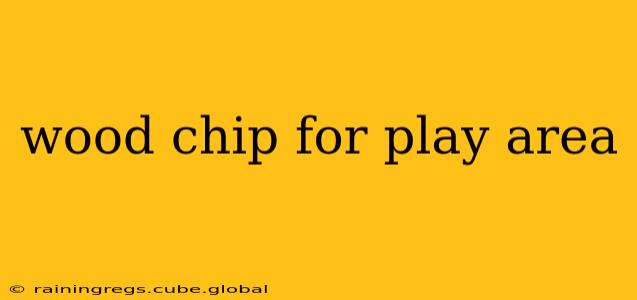Wood chips are a popular choice for playground surfacing, offering a cost-effective and aesthetically pleasing alternative to other materials. However, choosing the right wood chip for your play area requires careful consideration of several factors. This comprehensive guide will help you navigate the process, ensuring safety and enjoyment for children.
What are the benefits of using wood chips in a play area?
Wood chips provide a soft, cushioning surface that helps to reduce the impact of falls, minimizing the risk of injuries. They are relatively inexpensive compared to other surfacing options like rubber or poured-in-place materials. Furthermore, wood chips are naturally aesthetically pleasing, blending well with various landscape designs. Their natural look and feel create a warm and inviting play environment. Finally, wood chips are readily available in many areas, making them a convenient option for playground installations.
What types of wood chips are best for playgrounds?
Not all wood chips are created equal. The best wood chips for play areas are those that are:
- Durable: They should resist decay and insect infestation for a longer lifespan. Hardwoods generally fare better than softwoods in this regard.
- Safe: Free from harmful chemicals, splinters, and sharp edges. Properly processed and screened wood chips are crucial for safety.
- Uniform: Consistent in size and shape to create a level and even playing surface, reducing the risk of tripping hazards.
- Properly treated (if necessary): While untreated wood chips are preferred by some due to their natural properties, some treatments can enhance durability and resistance to decay without compromising safety (always check for certification and safety standards).
Choosing a hardwood like cedar or redwood is often recommended for its natural resistance to rot and insects. However, cost is a factor and other treated softwoods can be a viable option if properly sourced and certified.
What are the safety considerations when using wood chips?
Depth: The depth of the wood chip surface is critical for safety. Guidelines often recommend a minimum depth of at least 6-9 inches, depending on the height of the play equipment and the age of the children using the area. A deeper layer provides better impact absorption.
Regular Maintenance: Wood chips break down over time, losing their cushioning properties. Regular inspections and replenishments are vital to maintain safety. Areas with high use will require more frequent maintenance. Check for compaction and regularly rake the surface to redistribute the chips evenly and maintain the required depth. Remove any debris like stones, sticks, or other foreign objects.
Wood Type and Treatment: Ensure the wood chips are from a reputable source and meet safety standards. Look for certification that confirms they are free from harmful chemicals and preservatives. Always prioritize untreated wood chips if possible.
How much do wood chips cost for a play area?
The cost of wood chips varies depending on several factors:
- Type of wood: Hardwood chips are generally more expensive than softwood chips.
- Quantity needed: Larger play areas naturally require more wood chips.
- Delivery costs: Transportation costs can significantly impact the overall price.
- Regional variations: Prices can fluctuate based on location and availability.
It's best to obtain quotes from multiple suppliers to compare prices and ensure you're getting the best deal for your needs.
How often should I replace wood chips in my play area?
The frequency of wood chip replacement depends on factors like the type of wood, climate, and usage. As a general rule, you should expect to replace or replenish your wood chips every 1-3 years, but regular inspections are key. If the wood chips are significantly compacted, showing signs of decay, or if the depth has decreased below the recommended level, it is time for a refill or replacement.
Are there any alternatives to wood chips for playground surfacing?
Yes, there are several alternatives to wood chips for playground surfacing, including rubber mulch, poured-in-place rubber, engineered wood fiber, and pea gravel. Each option has its own advantages and disadvantages regarding cost, safety, maintenance, and environmental impact. Research these alternatives to find the best fit for your needs and budget.
By carefully considering these factors and choosing the right wood chips for your needs, you can create a safe, enjoyable, and attractive play area for children. Remember, safety should always be the top priority. Regular maintenance and inspections are crucial for ensuring the longevity and safety of your wood chip playground surfacing.
